Rose of Sharon Hibiscus syriacus White Chiffon = 'Notwoodtwo' (PBR) (Chiffon Series) (d)
![rose of Sharon [White Chiffon]](/_next/image?url=https%3A%2F%2Fplants-admin.emdemapps.com%2Fimages%2Fplants%2F%2Fimages%2F604b5d7b7a076.png&w=3840&q=75)
ABOUT
The Hibiscus syriacus White Chiffon, from the Chiffon Series, is an ornamental plant that features large, showy white flowers. The blossoms are characterized by their delicate, chiffon-like texture, with each petal presenting a slightly ruffled appearance that adds to their overall charm and softness. At the center of each flower, there's a prominent and contrasting reddish-pink to dark red throat, which helps attract pollinators. The petals are numerous and overlap in a way that creates a semi-double to double flower effect, giving the impression of a fuller bloom. This variety is particularly noted for its abundance of flowers, which stand out against the dark green, glossy leaves that form the backdrop of the plant's foliage. These leaves are broadly lance-shaped with toothed edges, and they grow neatly arranged along the branches, contributing to the plant's well-groomed appearance. When the plant is in full bloom, typically in late summer and continuing through to fall, it presents a stunning display that can turn heads and is often planted for its decorative appeal in gardens and landscapes. Overall, the Hibiscus syriacus White Chiffon is prized for its elegant white flowers which bring a touch of grace and sophistication to any garden setting. Its appearance is reminiscent of a classic hibiscus, with the added allure of its pure white, frilly flowers enriched by a colorful heart.
About this plant
 Names
NamesFamily
Malvaceae.
Synonyms
Rose Of Sharon, Shrub Althea, Korean Rose, Syrian Ketmia, Rose Mallow.
Common names
Hibiscus syriacus 'Notwoodtwo'.
 Toxicity
ToxicityTo humans
Rose of Sharon is not considered toxic to humans. However, like many plants, it may cause skin irritation or an allergic reaction in some individuals. There are no severe toxicity issues related to ingestion, but it's generally not recommended to eat ornamental plants. Ingesting this plant, especially in large amounts, could potentially cause stomach upset or nausea due to its non-edibility.
To pets
Rose of Sharon is known to be toxic to pets, especially dogs, cats, and horses. Ingesting this plant can cause gastrointestinal upset, such as vomiting and diarrhea. In some cases, more severe symptoms may occur, including lack of appetite, nausea, or even depression. It's advisable to keep pets away from Rose of Sharon and seek veterinary attention if they consume any part of the plant.
 Characteristics
CharacteristicsLife cycle
Perennials
Foliage type
Deciduous
Color of leaves
Green
Flower color
White
Height
8-12 feet (2.4-3.7 meters)
Spread
6-10 feet (1.8-3 meters)
Plant type
Shrub
Hardiness zones
5
Native area
Asia
Benefits
 General Benefits
General Benefits- Attracts Pollinators: The large, showy flowers provide nectar for bees, butterflies, and other pollinating insects.
- Easy Care: Requires minimal upkeep once established, making it ideal for busy gardeners.
- Drought Tolerant: Has the ability to withstand dry conditions, reducing the need for frequent watering.
- Long Blooming Period: Offers a lengthy season of blooms from mid-summer to fall, adding prolonged interest to the garden.
- Ornamental Value: The large white flowers with lacy centers add aesthetic appeal to garden designs.
 Medical Properties
Medical PropertiesThis plant is not used for medical purposes.
 Air-purifying Qualities
Air-purifying QualitiesThis plant is not specifically known for air purifying qualities.
 Other Uses
Other Uses- As a natural fabric dye: The flowers of the Rose of Sharon can be used to produce a delicate, natural dye for fabrics, yielding a subtle, light shade.
- In the creation of herbal teas: Although mainly ornamental, some choose to use the flowers of the Rose of Sharon in herbal tea blends for their mild flavor.
- As papermaking material: The fibrous parts of the Rose of Sharon can be pulped and used in the process of handcrafting paper.
- In landscaping for noise reduction: When planted in dense hedges, the Rose of Sharon can help to dampen and reduce noise pollution.
- As a nectar source for bees: Rose of Sharon is valued by beekeepers as a late summer source of nectar, which supports honey production during a time of year when few other flowers may be blooming.
- In ceremonies and cultural festivals: In some cultures, Rose of Sharon blossoms are used in decorative garlands or as part of traditional ceremonies.
- Educational use: This plant can be used in botanical studies to teach about plant biology and hybridization due to its interesting breeding history and various cultivars.
- As a pH indicator: The flowers of the Rose of Sharon can change color based on the acidity or alkalinity of the soil, which can be used as a rudimentary way to gauge soil pH.
- For attracting butterflies: The large, colorful flowers of the Rose of Sharon are known to attract butterflies, making it a great plant for butterfly gardens.
- In bonsai cultivation: Some enthusiasts use the Rose of Sharon for bonsai due to its attractive flowers and the ability to shape and train its branches.
Interesting Facts
 Feng Shui
Feng ShuiThe Rose of Sharon is not used in Feng Shui practice.
 Zodiac Sign Compitability
Zodiac Sign CompitabilityThe Rose of Sharon is not used in astrology practice.
 Plant Symbolism
Plant Symbolism- Delicate beauty: The White Chiffon variety of the Rose of Sharon, with its soft, fluffy white flowers, exemplifies a sense of delicate and understated beauty.
- Femininity: The flower's soft, layered petals can symbolize traditional notions of femininity and grace.
- Persistence: As the Rose of Sharon is a hardy plant that can withstand harsh conditions, it often represents the idea of persisting through challenges.
- New beginnings: Because the plant blooms in the late summer, it is frequently associated with new starts and the next chapter in life.
- Healing: In some cultural contexts, the Rose of Sharon is thought to have medicinal properties, and thus, it is a symbol of healing and restoration.
 Water
WaterRose of Sharon, commonly known as Hibiscus syriacus White Chiffon, should be watered thoroughly when the top inch of soil feels dry to the touch. This typically means watering deeply once a week, but frequency may increase to twice per week during extremely hot or dry conditions. When watering, it is important to avoid wetting the foliage to prevent fungal diseases. Provide the plant with about 1 to 1.5 gallons of water per session to ensure the root zone is adequately moistened, adjusting as necessary for your local conditions and soil type.
 Light
LightRose of Sharon prefers full sun to partial shade. The best spot for this plant would be a location where it can receive at least six hours of direct sunlight daily. It can tolerate some light shade, especially in hotter climates, but too much shade can lead to fewer blooms and a leggier plant.
 Temperature
TemperatureThe ideal temperature range for Rose of Sharon is between 60 and 90 degrees Fahrenheit. It can survive minimum temperatures down to about 20 degrees Fahrenheit and maximum temperatures as long as they are not sustained at over 100 degrees Fahrenheit for extended periods. This plant is quite hardy once established but should be protected from extreme cold when young.
 Pruning
PruningRose of Sharon benefits from pruning to maintain shape, encourage bushier growth, and enhance flowering. Prune in late winter or early spring before new growth begins. Remove any dead, damaged, or crossing branches and trim back last year's growth to shape the plant or maintain size. It can be pruned annually, as it flowers on new wood.
 Cleaning
CleaningAs needed
 Soil
SoilThe Rose of Sharon prefers well-draining soil enriched with organic matter. A mix containing loam, peat, and sand in equal parts is ideal. Amend the soil with compost for added nutrients. The soil pH should be between 6.0 and 7.5 for optimal growth and flowering.
 Repotting
RepottingRose of Sharon plants, when grown in containers, should be repotted every 2-3 years to prevent root crowding and to refresh the soil. This is typically done in late winter or early spring before new growth commences.
 Humidity & Misting
Humidity & MistingThe Rose of Sharon tolerates a wide range of humidity levels but thrives best in average humidity conditions. Excessive humidity is not required; normal outdoor conditions are generally suitable for this plant.
 Suitable locations
Suitable locationsIndoor
Place in bright, indirect light and monitor water.
Outdoor
Full sun to part shade, shelter from strong winds.
Hardiness zone
5-9 USDA
 Life cycle
Life cycleThe life cycle of the Rose of Sharon 'White Chiffon' begins with seed germination when planted in well-draining soil, ideally in late winter or early spring. After germination, it progresses to the seedling stage, where the young plant establishes its roots and begins to produce its first leaves. As it enters the vegetative growth stage, it develops a woody stem and branches, along with more mature leaves, in preparation for flowering. The plant reaches maturity and enters the flowering stage, typically in late spring to summer, producing its characteristic white, ruffled blooms that can attract pollinators. After pollination, the plant produces seed pods that mature in late summer to early fall, which can then be dispersed to start new plants. Finally, the Rose of Sharon 'White Chiffon' enters a period of dormancy in the winter, shedding leaves and conserving energy until the next growing season.
 Propogation
PropogationPropogation time
Late spring to early summer
The Hibiscus syriacus, commonly known as Rose of Sharon, can be effectively propagated through softwood stem cuttings. The best time to take these cuttings is in late spring to early summer, when the plant's new growth is still tender and not yet mature. To propagate, cut a healthy stem about 4 to 6 inches long, making sure to include several leaf nodes. Remove the leaves from the lower half of the cutting, and dip the cut end into a rooting hormone to encourage growth. Then insert the cutting into a pot filled with a mixture of perlite and peat moss, ensuring the leaf nodes are buried. Keep the pot in a warm, humid environment and maintain the soil moisture without overwatering. Roots typically develop within 4 to 6 weeks, after which the new plants can eventually be transplanted outdoors.
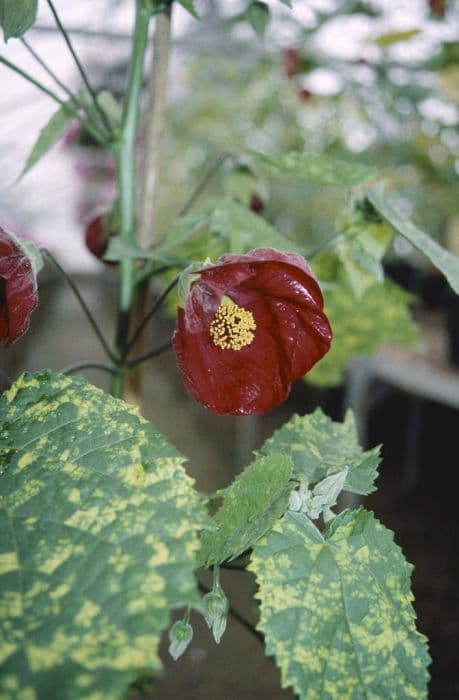
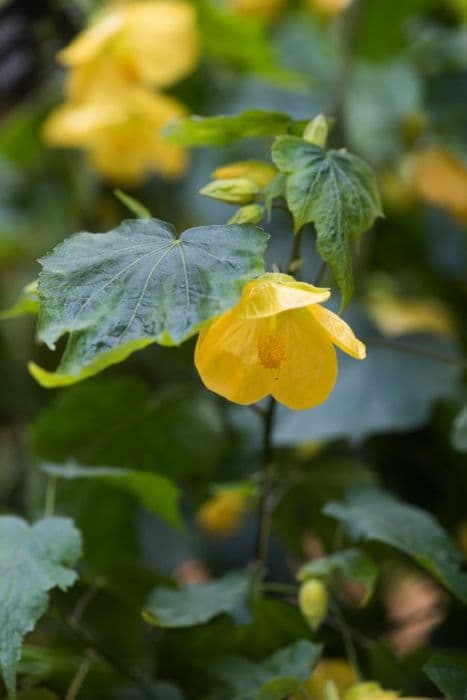
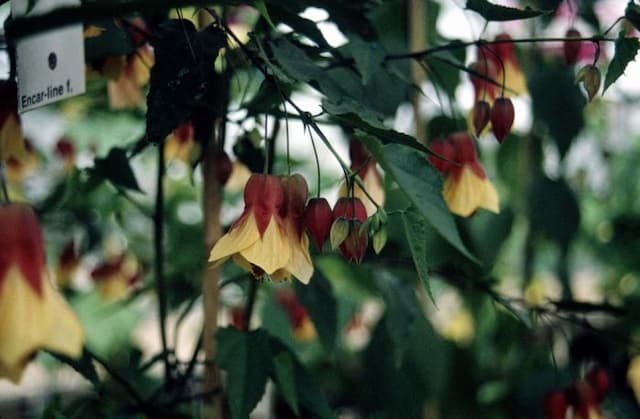
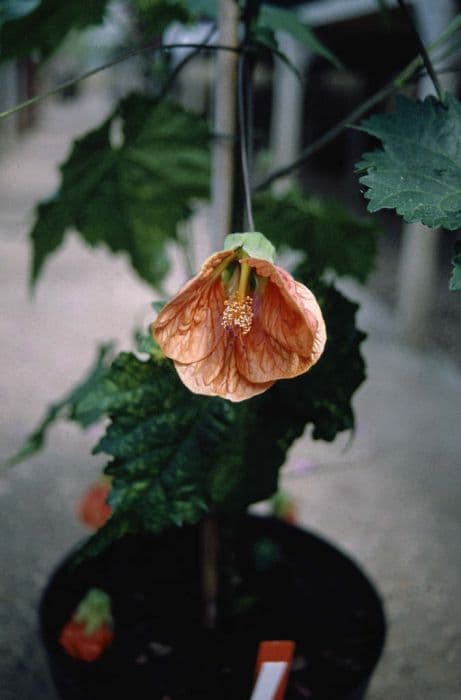
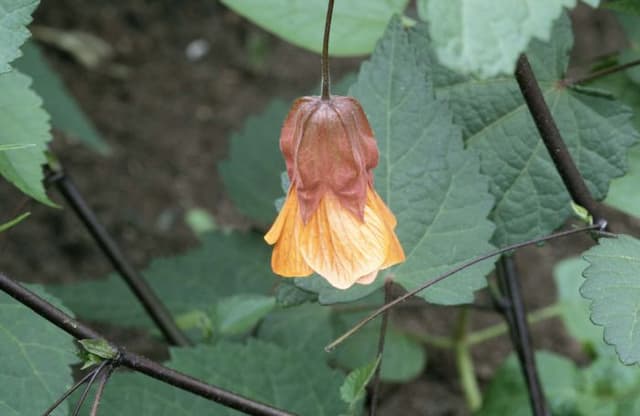

![Abutilon [Yellow Trumpet]](/_next/image?url=https%3A%2F%2Fplants-admin.emdemapps.com%2Fimages%2Fplants%2F%2Fimages%2F604b5caa8b4fb.png&w=640&q=75)

